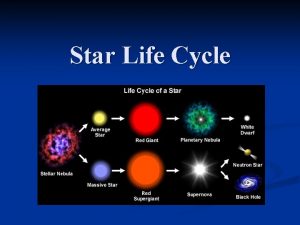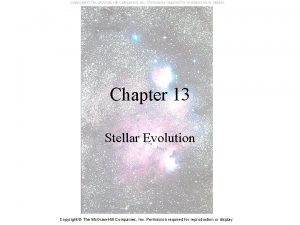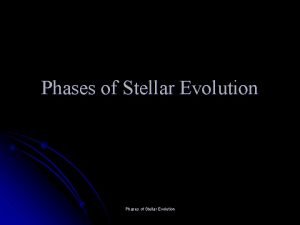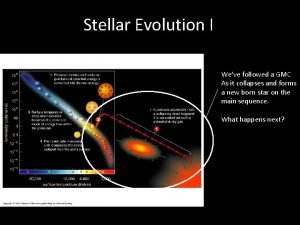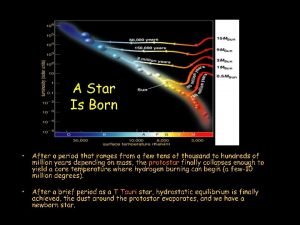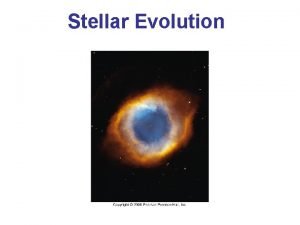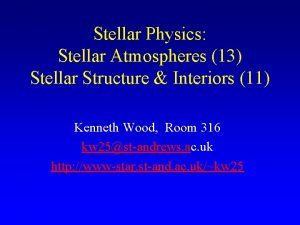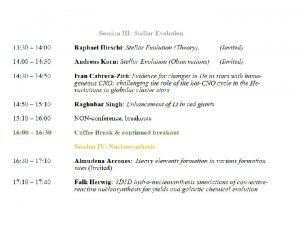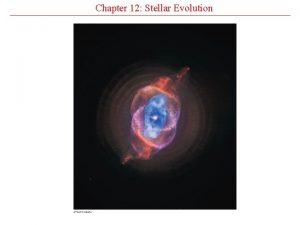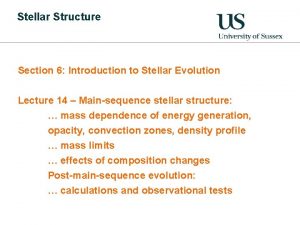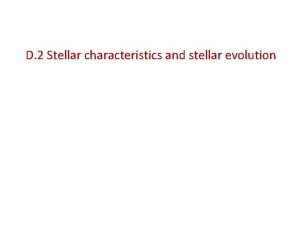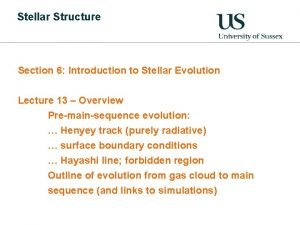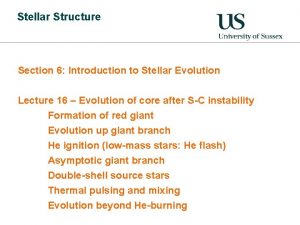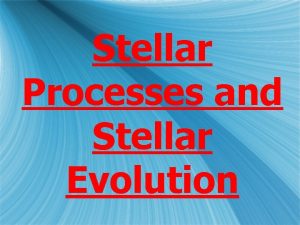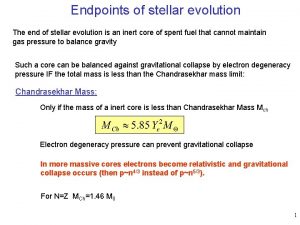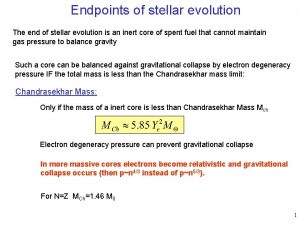Stellar Evolution I Weve followed a GMC As















- Slides: 15

Stellar Evolution I We’ve followed a GMC As it collapses and forms a new born star on the main sequence. What happens next?

What is the main sequence? • Where most stars (90%) appear to lie • Which means where stars spend 90% (on average) of their lives Why is their a main sequence? • The Sun is on the main sequence, so let’s start with our closest star • We know the structure of the Sun very well; so let’s look at the main ingredients that go into constructing a mathematical model of the Sun, and see what happens when we apply that model to Other stars.

The Ingredients of a Stellar Model • Hydrostatic Equilibrium • Energy transport • Mass Conservation (Total mass of star equals sum of the mass of each part of the star) • Energy conservation (Total energy coming out of the Sun (Luminosity) equals energy generated inside the Sun

So we apply our model to stars different to our Sun • Choose the mass of the star, and how energy is generated in the core • Guess Temperature, Pressure, Chemical Composition in Core (starts out with about 90% H, 10% He) • Work our way out using the basic ingredients of the stellar Model • Check surface conditions against a real star of that mass

Final ingredient: How is Energy Generated in a Main Sequence Star? • Hydrogen fused into Helium • He nucleus has 0. 7% less mass than 4 H nuclei – that mass is turned into energy (E = mc 2) • Starts working at temperatures > 5, 000 K • Most efficient above 10, 000 K (Sun’s core 15, 000 K) • By fusing a match head’s worth of H to He you get as much energy as about gallons of gasoline would supply • Sun converts 5 million tons of mass into energy every second

Final ingredient: How is Energy Generated in a Main Sequence Star? • Pressure-Temperature Thermostat: • The hotter the core, the faster the fusion reactions • The faster the fusion reactions, the greater the rate of energy production • The greater the rate of energy production, the more the outer layers are heated, and the greater the pressure

The Main Sequence Explained! • The more massive the star, the greater the force of gravity pulling the star inwards 1 Solar Mass 15 Solar Masses

The Main Sequence Explained! • Therefore the higher the pressure in the interior (Hydrostatic eq. ) 1 Solar Mass 15 Solar Masses

The Main Sequence Explained! • Therefore the higher temperature in the core 1 Solar Mass 15, 000 K 15 Solar Masses 34, 000 K

The Main Sequence Explained! • Therefore, the greater the rate of energy generation which supplies the greater pressure needed to support the star 1 Solar Mass 15, 000 K 15 Solar Masses 34, 000 K

The Main Sequence Explained! • The energy eventually reaches the surface and radiates into space – so the luminosity of the star is higher 1 Solar Mass 1 LSUN 15, 000 K 15 Solar Masses 13000 LSUN 34, 000 K

The Main Sequence Explained! • The radius does not increase enough to keep the surface temperature the same, so the star is hotter and bluer 1 Solar Mass 1 LSUN 15 Solar Masses 13000 LSUN 34, 000 K 15, 000 K 6000 K 35, 000 K

Evolution of Stars on the Main Sequence • Core starts with same fraction of hydrogen as whole star • Fusion changes H He • For each reaction, the star loses 4 H and gains only one He, so pressure decreases and gravity squeezes the core more tightly • Core gradually shrinks and gets hotter, increasing the pressure to compensate • Energy generation rate gradually increases, so star gets more luminous and the surface gets hotter. Increased pressure of radiation increases the radius gradually H > He

Evolution of Stars on the Main Sequence

Evolution of Stars on the Main Sequence • Lifetime of stars on the main sequence: • More massive stars burn their fuel faster, so will use it up quicker > have smaller lifetimes • Lifetime T = 1/M 2. 5 • O 5 - 1, 000 yr • A 0 - 440, 000 yr • G 0 - 8, 000, 000 yr • K 0 - 17, 000, 000 yr • M 0 - 56, 000, 000 yr • (age of universe: 13, 600, 000 yr)
